
A tank locomotive or tank engine is a steam locomotive that carries its water in one or more on-board water tanks, instead of a more traditional tender. Most tank engines also have bunkers to hold fuel; in a tender-tank locomotive a tender holds some or all of the fuel, and may hold some water also.

The London, Brighton and South Coast Railway was a railway company in the United Kingdom from 1846 to 1922. Its territory formed a rough triangle, with London at its apex, practically the whole coastline of Sussex as its base, and a large part of Surrey. It was bounded on its western side by the London and South Western Railway (L&SWR), which provided an alternative route to Portsmouth. On its eastern side the LB&SCR was bounded by the South Eastern Railway (SER)—later one component of the South Eastern and Chatham Railway (SE&CR)—which provided an alternative route to Bexhill, St Leonards-on-Sea, and Hastings. The LB&SCR had the most direct routes from London to the south coast seaside resorts of Brighton, Eastbourne, Worthing, Littlehampton and Bognor Regis, and to the ports of Newhaven and Shoreham-by-Sea. It served the inland towns and cities of Chichester, Horsham, East Grinstead and Lewes, and jointly served Croydon, Tunbridge Wells, Dorking and Guildford. At the London end was a complicated suburban and outer-suburban network of lines emanating from London Bridge and Victoria, and shared interests in two cross-London lines.
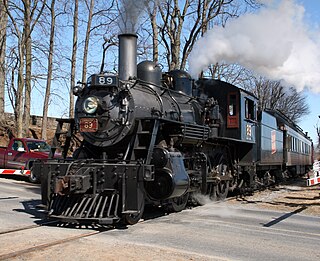
Under the Whyte notation for the classification of steam locomotives, 2-6-0 represents the wheel arrangement of two leading wheels on one axle, usually in a leading truck, six powered and coupled driving wheels on three axles and no trailing wheels. This arrangement is commonly called a Mogul.
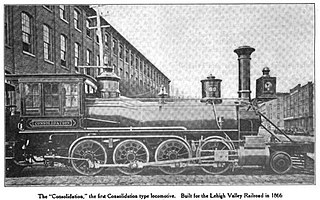
Under the Whyte notation for the classification of steam locomotives, 2-8-0 represents the wheel arrangement of two leading wheels on one axle, usually in a leading truck, eight powered and coupled driving wheels on four axles, and no trailing wheels. In the United States and elsewhere, this wheel arrangement is commonly known as a Consolidation, after the Lehigh and Mahanoy Railroad’s Consolidation, the name of the first 2-8-0.
A wide variety of steam locomotives have been used on Ireland's railways. This page lists most if not all those that have been used in the Republic of Ireland and Northern Ireland. Irish railways generally followed British practice in locomotive design.

Under the Whyte notation for the classification of steam locomotives, a 2-6-4 locomotive has two leading wheels, six coupled driving wheels and four trailing wheels. This arrangement is commonly called Adriatic.
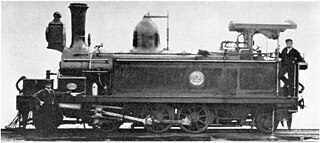
Under the Whyte notation for the classification of steam locomotives, 2-6-2 represents the wheel arrangement of two leading wheels, six coupled driving wheels and two trailing wheels. This arrangement is commonly called a Prairie.

Cork, Bandon and South Coast Railway (CB&SCR), was an Irish gauge railway in Ireland. It opened in 1849 as the Cork and Bandon Railway (C&BR), changed its name to Cork Bandon and South Coast Railway in 1888 and became part of the Great Southern Railway (GSR) in 1924.

Under the Whyte notation for the classification of steam locomotives, 0-4-2 represents the wheel arrangement with no leading wheels, four powered and coupled driving wheels on two axles and two trailing wheels on one axle. While the first locomotives of this wheel arrangement were tender engines, the configuration was later often used for tank engines, which is noted by adding letter suffixes to the configuration, such as 0-4-2T for a conventional side-tank locomotive, 0-4-2ST for a saddle-tank locomotive, 0-4-2WT for a well-tank locomotive and 0-4-2RT for a rack-equipped tank locomotive. The arrangement is sometimes known as Olomana after a Hawaiian 0-4-2 locomotive of 1883.
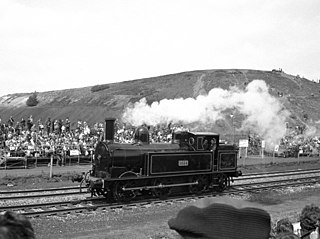
Under the Whyte notation for the classification of steam locomotives, 0-6-2 represents the wheel arrangement of no leading wheels, six powered and coupled driving wheels on three axles and two trailing wheels on one axle. The type is sometimes known as a Webb or a Branchliner.

The London, Brighton and South Coast Railway E3 class were 0-6-2T side tank steam locomotives. One prototype was designed by William Stroudley shortly before his death, but was completed by R. J. Billinton, who later built sixteen further locomotives.

The Schull and Skibbereen Railway was a minor narrow gauge railway in County Cork, Ireland. It opened in 1886 and closed in 1947. The track gauge was a 3 ft narrow gauge. The formal name of the company was The West Carberry Tramways and Light Railways Company Ltd.

The Cork, Blackrock and Passage Railway known locally to the locals as The Black Bridge (CB&PR) was a 3 ft narrow gauge railway in County Cork, Ireland. The line originally opened in 1850 as a 5 ft 3 in Irish standard gauge railway between Cork and Passage West and operated steam feeder ferries to other locations round Cork Harbour. The company was heavily dependent on summer tourist traffic for a considerable proportion of its revenue. The railway was converted to 3 ft narrow gauge in 1900 in conjunction with extensions southwards to Crosshaven which were completed in 1904. The railway closed in 1932 and has since been replaced by a public pathway and nature area.
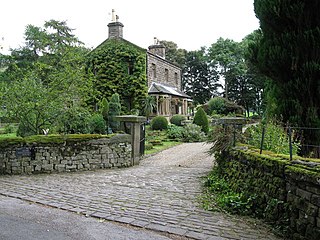
Nidd Valley Light Railway was a light railway in upper Nidderdale in the West Riding of Yorkshire, England. It was owned by Bradford Corporation Waterworks Department and the corporation also operated its public passenger services. Power & Traction Ltd of London obtained a Light Railway Order for the 6.5-mile (10.5 km) railway from Pateley Bridge to Lofthouse in 1900, but these powers were taken over by Bradford Corporation. A contract to build Angram Reservoir was awarded to John Best & Son in 1903, and he also won the contract to build the public railway and a 6.5-mile (10.5 km) private extension to the reservoir site. This was initially built to 3 ft gauge but was converted to standard gauge by 1907, when the public railway opened. Best had his own locomotives, and Bradford Corporation equipped the public railway with second hand locomotives and carriages from the Metropolitan Railway.

The GWR Class 850 was an extensive class of small 0-6-0ST locomotives designed by George Armstrong and built at the Wolverhampton railway works of the Great Western Railway between 1874 and 1895. Aptly described as the GWR equivalent of the LB&SCR "Terrier" Class of William Stroudley, their wide availability and lively performance gave them long lives, and eventually they were replaced from 1949 by what were in essence very similar locomotives, the short-lived 1600 Class of Frederick Hawksworth, which in the headlong abandonment of steam outlived them by a mere seven years or so.
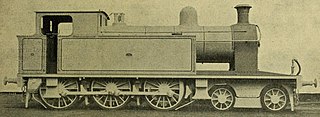
The CBSCR Bandon Tanks were a class of 4-6-0T mixed-traffic locomotives built for the Cork, Bandon and South Coast Railway (CB&SCR) between 1906 and 1920. The Bandon Tanks were the only 4–6–0 tank locomotives to be built by Beyer, Peacock and Company. The class went on to serve with the CB&SCR's successors: the Great Southern Railways from 1925 and Córas Iompair Éireann from 1945.

Cork Albert Quay railway station was on the Cork, Bandon and South Coast Railway in County Cork, Ireland.

The Cork and Macroom Direct Railway (CMDR) was an Irish gauge railway in Ireland which ran the 24 miles (39 km) from Cork to Macroom.
The GS&WR McDonnell 2-4-0 types were a set of passenger locomotive classes introduced on the Great Southern and Western Railway (GS&WR) of Ireland by its locomotive engineer Alexander McDonnell between about 1868 and 1877.
The Cork & Bandon 0-6-0 Beyer saddle tank was a class of five six-coupled locomotives supplied to the Cork and Bandon Railway (C&BR) between 1881 and 1894 by Beyer, Peacock & Company. They were, for a short while on introduction, to be the railway's principle motive power.

















